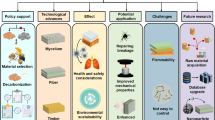Abstract
There have been many studies on bio-inspired research, where biomimicry capabilities facilitating sustainable designs are in dearth. For a sustainable design, it is necessary to consider water efficiency, zero waste, thermal environment, and energy supply. This paper investigates how biomimicry is adopted in the sustainable design of buildings. A thorough content analysis of eight case studies focused on the built environment and how biomimicry integrated with the design of a building was executed. The selection of cases study was based on the concept of biomimicry by taking inspiration from nature and applying them in the everyday built environment. Thus, the building designs are more ecologically sustainable than conventional ones, where biomimicry approaches and principles are adopted. The findings suggest that the design of a building can inspire society with new ecological morals, where understanding of biological morphogenesis can inspire design to resolve challenges and essentially help create a healthy environment. Biomimicry harnesses and replicates the principles found in nature to create a built environment that benefits people and other living creatures and safeguards biodiversity. Thus, adopting biomimicry in designing a building will help to develop a culture of active environmental design.






Similar content being viewed by others
Data availability
Social Science
References
Benyus JM (1997) Biomimicry: innovation inspired by nature. Morrow, New York
Benyus JM (2011) A biomimicry primer. Biomimicry 3.8
Benyus J, Schwan B (2006) Biomimicry institute. Retrieved from Biomimicry Institute: https://biomimicry.org/what-is-biomimicry/. Accessed 5 June 2021
Benyus J, Mcgee T, Ritter S (2009) Biomimicry in community planning. Biomimicry Institute. http://www.biomimicryinstitute.org/. Accessed 5 June 2021
Dash SP (2018) Application of biomimicry in building design. Intl J Civil Eng Technol 9(2):644–660
Elsamadisy R, Sarhan AE, Farghaly Y, Mamdouh A (2019) Biomimicry as a design approach for adaptation. J Al-Azhar Univ Eng Sector 14(53):1516–1533. https://doi.org/10.21608/AUEJ.2019.64210
Hwang J, Jeong Y, Park JM, Lee KH, Hong JW, Choi J (2015) Biomimetics: forecasting the future of science, engineering, and medicine. Int J Nanomedicine 10:5701–5713. https://doi.org/10.2147/IJN.S83642
Mansour H (2010) Biomimicry a 21st century design strategy integrating with nature in a sustainable way. Proceedings of the First International Conference on Sustainability and the Future, The British University in Egypt, BUE-FISC 2010 – 12.
Mirniazmandan S, Rahimianzarif E (2017) Biomimicry an approach toward sustainability of high-rise buildings. J Arch Eng Technol 06(02). https://doi.org/10.4172/2168-9717.1000203
Mohd Ariffin NA, Farag Gad S (2017) Content analysis of the existence of biomimicry life’s principles in Green Building Index Malaysia. Planning Malaysia 15(1):179–190. https://doi.org/10.21837/pm.v15i1.233
Okeke FO, Okeke OCJ, Adibe FA (2017) Biomimicry and sustainable architecture: a review of existing literature. J Environ Manag Safety 8(1):11–24
Othmani NI, Sahak NM, Yunos MYM (2021) Biomimicry in agrotechnology: future solution of water problem for the agriculture industry? IOP Conf Ser Earth Environ Sci 756(1). https://doi.org/10.1088/1755-1315/756/1/012051
Peters T (2011) Nature as measure: the biomimicry guild. Archit Des 81(6):44–47. https://doi.org/10.1002/ad.1318
Reap, J. (2014). Holistic biomimicry: a biologically inspired approach to environmentally benign engineering Georgia Institute of Technology.
Rossin KJ (2010) Biomimicry: nature’s design process versus the designer’s process. Paper presented at the Design and Nature V
Shahda M, Elmokadem AA (2018) Biomimicry levels as an approach to architectural sustainability. Port Said Eng Res J, 10
Uchiyama Y, Blanco E, Kohsaka R (2020) Application of biomimetics to architectural and urban design: a review across scales. Sustainability 12(23). https://doi.org/10.3390/su12239813
Wanieck K, Fayemi P-E, Maranzana N, Zollfrank C, Jacobs S (2017) Biomimetics and its tools. Bioins Biomim Nanobiomater 6(2):53–66. https://doi.org/10.1680/jbibn.16.00010
Zari MP (2016) Biomimetic approaches to architectural design for increased sustainability
Acknowledgement
This research was supported by the Graduate Research Fellowship (GRF) of Universiti Putra Malaysia and UMK-Fundamental Research.
Author information
Authors and Affiliations
Contributions
Nurul Izzati Othmani, Syahidah Amni Mohamed, Nor Hamizah Abdul Hamid, Noorliyana Ramlee, Yeo Lee Bak, and Mohd Yazid Mohd Yunos contributed to the design and implementation of the research, to the analysis of the results, and to the writing of the manuscript.
Corresponding author
Ethics declarations
Ethics approval
This is a review study. The researchers have confirmed that no ethical approval is required.
Consent to participate
Not applicable
Consent to publish
Not applicable
Competing interests
The authors declare no competing interests.
Additional information
Responsible Editor: Philippe Garrigues
Publisher’s note
Springer Nature remains neutral with regard to jurisdictional claims in published maps and institutional affiliations.
Rights and permissions
Springer Nature or its licensor holds exclusive rights to this article under a publishing agreement with the author(s) or other rightsholder(s); author self-archiving of the accepted manuscript version of this article is solely governed by the terms of such publishing agreement and applicable law.
About this article
Cite this article
Othmani, N.I., Mohamed, S.A., Abdul Hamid, N.H. et al. Reviewing biomimicry design case studies as a solution to sustainable design. Environ Sci Pollut Res 29, 69327–69340 (2022). https://doi.org/10.1007/s11356-022-22342-z
Received:
Accepted:
Published:
Issue Date:
DOI: https://doi.org/10.1007/s11356-022-22342-z




